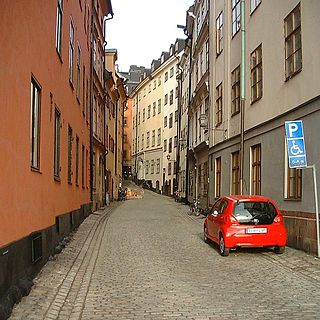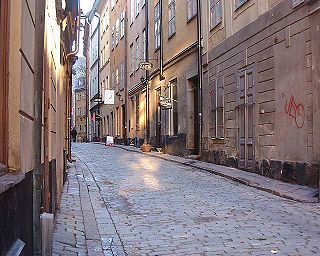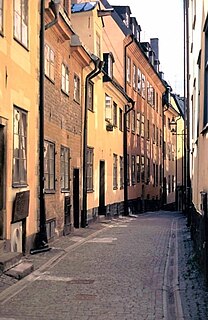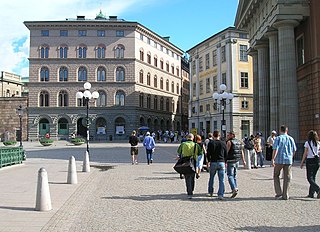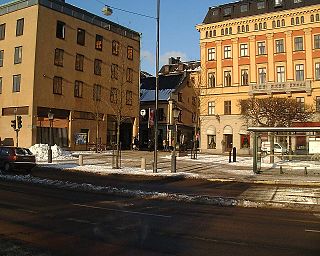

Skomakargatan (Swedish: "The Shoemaker Street") is a street in Gamla stan, the old town of Stockholm, Sweden, Stretching between the square Stortorget and the streets Kindstugatan and Tyska Brinken, it forms a parallel street to Prästgatan and Svartmangatan.
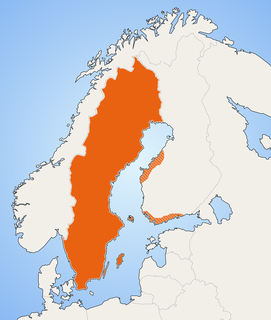
Swedish is a North Germanic language spoken natively by 9.6 million people, predominantly in Sweden, and in parts of Finland, where it has equal legal standing with Finnish. It is largely mutually intelligible with Norwegian and to some extent with Danish, although the degree of mutual intelligibility is largely dependent on the dialect and accent of the speaker. Both Norwegian and Danish are generally easier for Swedish speakers to read than to listen to because of difference in accent and tone when speaking. Swedish is a descendant of Old Norse, the common language of the Germanic peoples living in Scandinavia during the Viking Era. It has the most speakers of the North Germanic languages.

A street is a public thoroughfare in a built environment. It is a public parcel of land adjoining buildings in an urban context, on which people may freely assemble, interact, and move about. A street can be as simple as a level patch of dirt, but is more often paved with a hard, durable surface such as concrete, cobblestone or brick. Portions may also be smoothed with asphalt, embedded with rails, or otherwise prepared to accommodate non-pedestrian traffic.
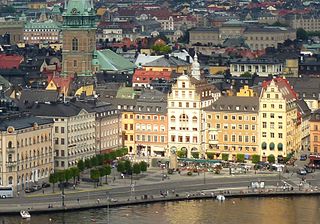
Gamla stan, until 1980 officially Staden mellan broarna, is the old town of Stockholm, Sweden. Gamla stan consists primarily of the island Stadsholmen. Officially, but not colloquially, Gamla stan includes the surrounding islets Riddarholmen, Helgeandsholmen, and Strömsborg.
Contents
Together with Köpmangatan, Skomakargatan is the oldest preserved street name in Gamla stan. In 1337 it is referred to as (in Latin) in vico sutorum ("on the street of the shoemakers"), and the street remained the established quarters for the trade until the early 18th century. [1]
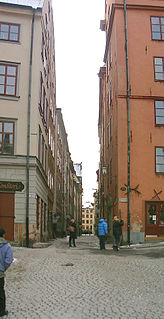
Köpmangatan is a street in Gamla stan, the old town of Stockholm, Sweden. A parallel street to Trädgårdsgatan, it stretches from the central square Stortorget to Köpmantorget, intercepted by Trädgårdstvärgränd, Skeppar Olofs Gränd, Peder Fredags Gränd, Själagårdsgatan, Staffan Sasses Gränd, Baggensgatan, and Bollhusgränd.
The royal weaving mill was located on the street in the 16th century, as were two guild lounges (gillehus) dedicated to St Olof (Saint Olav) and Helga Lekamen (The Holy Body of Christ). [2] [3] (See also Helga Lekamens Gränd.)

A guild is an association of artisans or merchants who oversee the practice of their craft/trade in a particular area. The earliest types of guild formed as a confraternities of tradesmen. They were organized in a manner something between a professional association, a trade union, a cartel, and a secret society. They often depended on grants of letters patent from a monarch or other authority to enforce the flow of trade to their self-employed members, and to retain ownership of tools and the supply of materials. A lasting legacy of traditional guilds are the guildhalls constructed and used as guild meeting-places. Guild members found guilty of cheating on the public would be fined or banned from the guild.
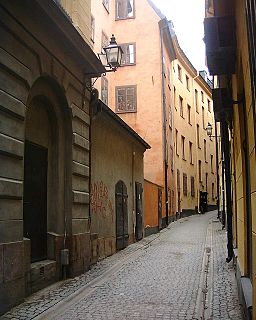
Helga Lekamens Gränd is an alley in Gamla stan, the old town in central Stockholm, Sweden. Connecting Västerlånggatan to Stora Nygatan, it forms a parallel street to Stora Gråmunkegränd and Göran Hälsinges Gränd.
Before Tyska kyrkan (the German Church) was built in the early 17th century, the street south of Skomakargatan was called Skomakarebrinken ("The Shoemakers Slope") or, in reference to the local city gate, Skomakarporten ("Shoemaker's Gate"). [1]

The German Church, sometimes called St. Gertrude's Church, is a church in Gamla stan, the old town in central Stockholm, Sweden, belonging to the German Saint Gertrude Parish of the Church of Sweden.

A city gate is a gate which is, or was, set within a city wall.
Skomakargatan is also one of the main sceneries in the story of The Member of Parliament and the Beautiful Dalecarlian Girl, a story about a young woman, Pilt Carin Ersdotter (1814–1885), who came to Stockholm from Dalarna to work as a milkmaid, and quickly became famous for her beauty. A count Rudolph fell madly in love with her, and she was regularly invited to parties otherwise only attended by wealthy people. At one occasion the police even interrogated her because she blocked the street with her beauty, however freeing her over the charges because "beauty is not a crime". She resisted all admirers in the capital to return to her fiancé in Dalarna, and became the subject for many songs and tales long after her departure. [4]
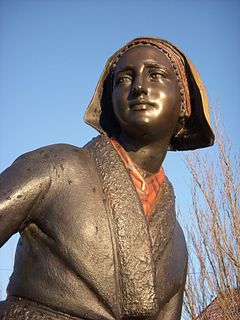
Pilt Carin Ersdotter (1814–1885), was a Swedish milkmaid from Djura in Dalarna who became famous for her beauty. She sold milk on the street of Stockholm in 1833-1834, and attracted so much attention that she became a mascot to be displayed in the salons of the aristocracy for money. Being a girl from Dalarna, she was called "dalkulla" and known as "Vackra dalkullan".

Dalarna, is a historical province or landskap in central Sweden. Another English language form established in literature is the Dales.



